

Jackfruit, known scientifically as Artocarpus heterophyllus, is a tropical fruit native to the rainforests of South and Southeast Asia. It is the largest fruit that grows on a tree and has gained significant popularity in recent years due to its versatility and unique characteristics. In this essay, we will explore the various aspects of jackfruit, including its appearance, flavor, nutritional value, cultivation, and culinary uses.
Firstly, jackfruit is a visually impressive fruit. It can reach enormous sizes, weighing up to 80 pounds (36 kilograms) and measuring up to 3 feet (91 centimeters) in length. Its outer skin is thick and spiky, with a greenish-yellow color when ripe. Inside, the fruit is composed of multiple yellow, fleshy bulbs, each containing a large seed. The seeds are edible and often used in various culinary preparations.

Secondly, jackfruit has a unique flavor profile. When fully ripe, the fruit has a sweet, tropical taste that resembles a combination of pineapple, mango, and banana. It has a subtly tangy and juicy texture that is both refreshing and satisfying. In addition to its natural sweetness, young, unripe jackfruit has a neutral flavor, making it an excellent base for savory dishes.
Next, let's delve into the nutritional value of jackfruit. It is a rich source of essential nutrients such as dietary fiber, vitamin C, potassium, and magnesium. The fruit is also low in calories and fat, making it a healthy addition to one's diet. Furthermore, jackfruit contains antioxidants and phytonutrients that contribute to its potential health benefits, including improved digestion, strengthened immune system, and reduced risk of chronic diseases.
Moving on to cultivation, jackfruit trees thrive in tropical and subtropical regions with a warm and humid climate. They require well-drained soil and plenty of sunlight to grow optimally. The tree itself is majestic, with a dense canopy and large, glossy leaves. It takes several years for a jackfruit tree to bear fruit, but once established, it can produce an abundant harvest for many years.
Lastly, let's explore the culinary uses of jackfruit. Its versatility is truly remarkable. The ripe fruit is commonly enjoyed fresh, either by itself or in fruit salads and smoothies. It can also be used in desserts, jams, and ice creams. In Asian cuisines, young, unripe jackfruit is often used as a meat substitute due to its fibrous texture, which resembles pulled pork or shredded chicken. It can be cooked and seasoned to create vegetarian and vegan dishes like curries, stir-fries, and sandwiches.
Thank you for reading…..
VVJK……
